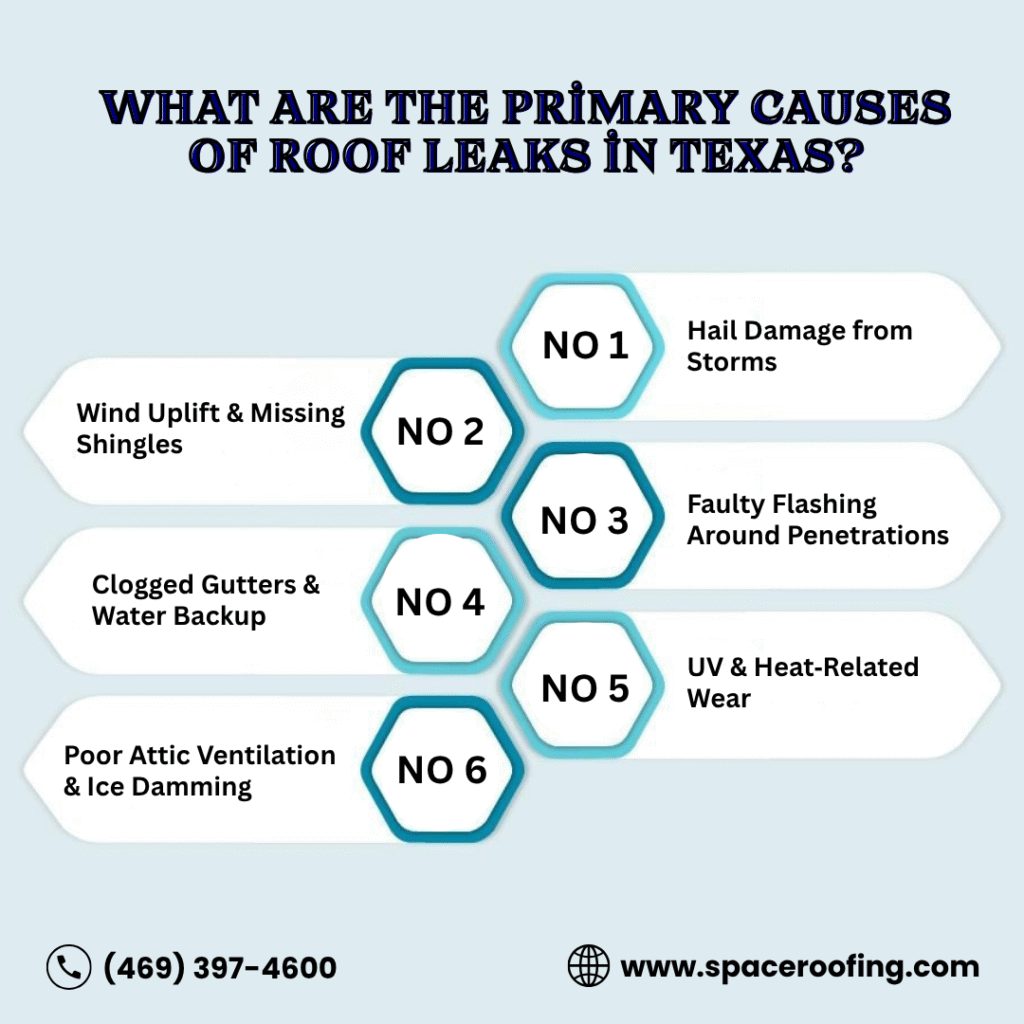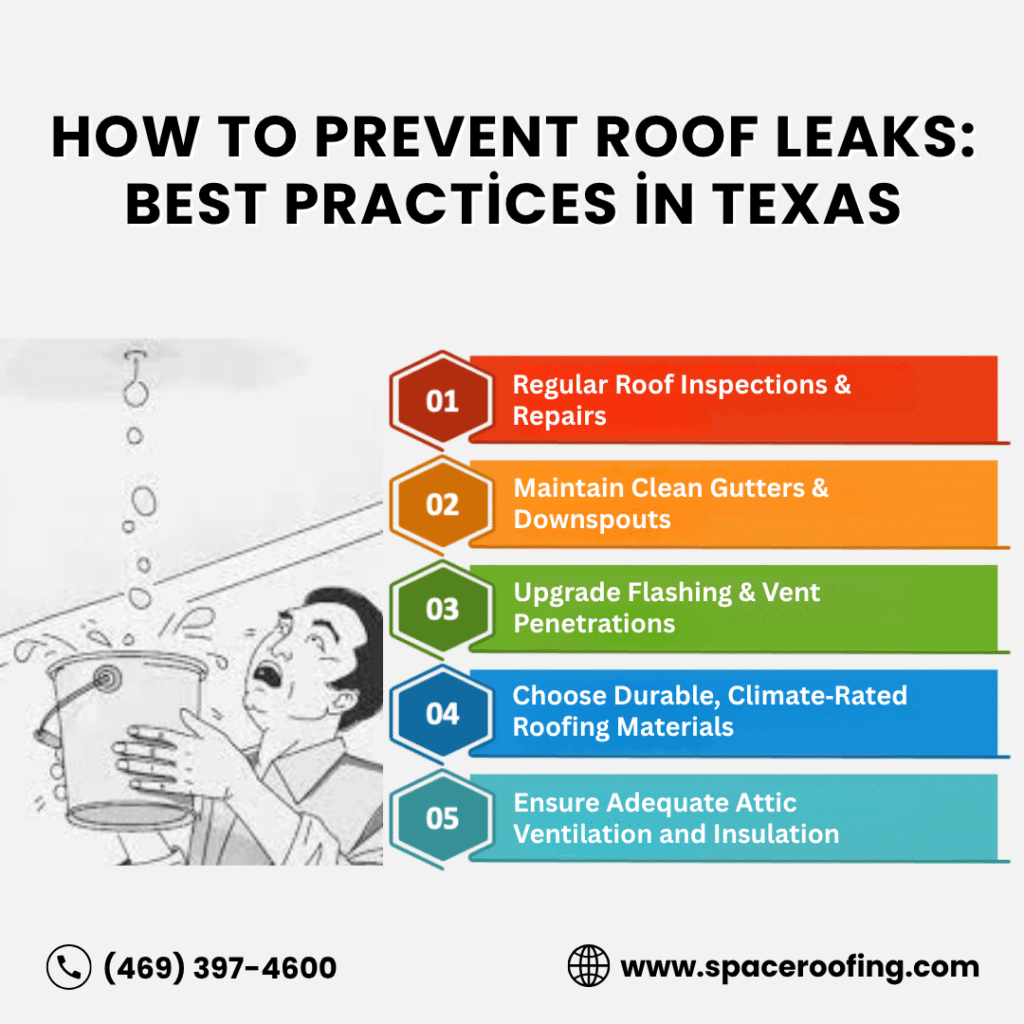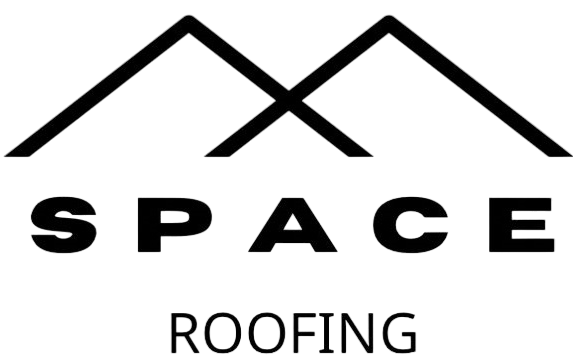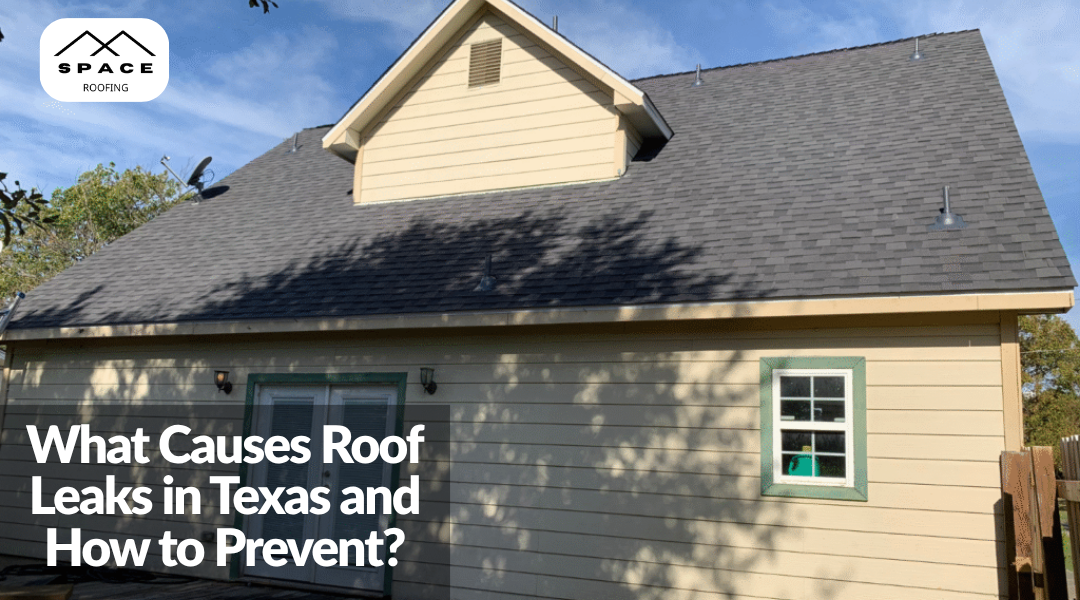Roof leaks damage homes, from Flower Mound to Austin. Knowing their causes and how to prevent them protects your investment. In Texas, extreme heat, hailstorms, and aging roofs contribute to some of the highest roofing claims in the nation. A single storm can leave behind hail damage, loose asphalt shingles, or clogged gutter systems, all of which increase the chance of leaks.
Understanding the roof leak causes, recognizing signs early, and following proven leak prevention steps can save thousands in repairs. Whether you live in Houston, Weatherford, or Plano, this guide is tailored for Texas weather conditions and best roofing practices.
Let’s examine the most common causes of leaks and preventative strategies.
What Are the Primary Causes of Roof Leaks in Texas?

Texas’ extreme weather and maintenance issues lead the list of leak triggers. From hail to high winds and neglected flashing, multiple elements compromise your roofing system over time. Grouped by weather, wear, and installation issues, these are the major culprits homeowners should watch for.
Below, we break down the top leak sources Texans face year-round and how they happen.
1. Hail Damage from Storms
Hail dents often cause hidden fracturing, creating leak points. Even small hailstones can dislodge asphalt granules, fracture shingle mats, or expose underlayment. These fractures compromise waterproofing and weaken your roofing system. Texas ranks among the top 10 states for hail events, and studies indicate that hail-damaged repair vehicles increase the risk of leaks by 35%. Without proper inspection, these hidden breaches may go undetected until serious interior damage occurs.
Post-storm roof inspections using drones or thermal imaging are critical, even if damage isn’t visible from the ground.
2. Wind Uplift & Missing Shingles
High winds, with gusts reaching 80 mph, can dislodge shingles and expose the underlayment. Once the protective roofing layer is compromised, rainwater seeps beneath, damaging decking, attic insulation, and even electrical systems. Over time, repeated gusts loosen shingle tabs, especially if proper wind‑rated shingles were not installed during construction.
In many Texas regions, seasonal storms and tornadoes increase the risk of wind uplift leaks, even in newer builds with seemingly secure roofs. Routine post-storm inspections help spot missing or lifted shingles early, before leaks and rot set in.
3. Faulty Flashing Around Penetrations
Leaky flashings are among the top leak sources, especially around chimneys, skylights, and roof penetrations. Weak or deteriorated pipe boots, skylight seams, or roof valleys allow water to enter the roof system. Flashing failures often result from improper installation, thermal expansion, or age-related corrosion.
These leaks are sneaky; they travel behind walls or ceilings, often going unnoticed until mold, staining, or structural decay appear. Routine inspections by a certified roofing contractor can help reinforce or replace compromised flashings.
→ Learn how to secure these spots in our Flashing Leak Prevention Tips.
4. Clogged Gutters & Water Backup
Debris‑filled gutters cause water to back up under shingles. As leaves and gunk clog downspouts, rainwater overflows and pools near fascia boards and roof valleys. Without proper flow, water penetrates the lower roof edge, causing rot, leaks, and even foundation issues if runoff isn’t redirected.
Clogged gutter leaks are entirely preventable. Cleaning gutters in the spring and fall, installing gutter guards, and inspecting for sagging sections are simple ways to prevent major roofing damage.
→ Read our full Seasonal Gutter Maintenance Guide.
5. UV & Heat‑Related Wear
Texas sun reduces shingle longevity by 20–25% over time. Continuous UV exposure strips protective asphalt granules, weakens membranes, and increases the brittleness of shingles. Without reflective coatings or light-colored roofing, heat buildup becomes extreme, especially on darker rooftops.
Over time, shingles dry out, crack, and curl, allowing rainwater to seep in. Homes without attic ventilation are prone to accelerated damage. Schedule annual inspections to detect thermal cycling wear and add cool-roof technologies to extend your roof’s life.
6. Poor Attic Ventilation & Ice Damming
In winter, poor attic vents create ice dams that force meltwater into the roof. Without proper ridge and soffit vents, attic heat melts snow unevenly. This meltwater then refreezes near the eaves, forming ice dams that trap water under shingles.
While uncommon across most of Texas, ice damming can occur in North Texas and Amarillo during rare winter storms. The trapped moisture can warp decking, encourage mold growth, and compromise insulation. A properly insulated attic with R‑38 insulation and steady airflow prevents this from happening.
How to Prevent Roof Leaks: Best Practices in Texas

Once you have identified the causes, implement these prevention strategies. From material upgrades to seasonal care, proactive planning can eliminate common vulnerabilities. Biannual inspections, regular maintenance, and using climate‑rated materials are key to leak‑proofing your home.
Here are the top roof leak prevention steps trusted by Texas professionals.
1. Regular Roof Inspections & Repairs
Schedule biannual inspections, especially post-storm. A certified roofing contractor uses thermal imaging and moisture meters to detect leaks early. These checks spot torn shingles, cracked flashing, and ventilation issues before they escalate.
The National Roofing Contractors Association recommends inspection every spring and fall. Early detection can prevent full-roof replacements and lower insurance claim costs.
2. Maintain Clean Gutters & Downspouts
Clear gutters each spring and fall. Blocked downspouts cause water to pool along eaves, damaging fascia boards and rotting decking. Regular cleaning or installing gutter guards, ensures proper drainage during storms.
This simple habit significantly reduces your risk of clogged gutter leaks, especially in leafy neighborhoods across Houston, Austin, and Weatherford.
3. Upgrade Flashing & Vent Penetrations
Replace old flashings with metal‑lined, code‑compliant installations. Most flashing failures result from age or improper sealing. Focus on areas around chimneys, vent pipes, skylights, and wall junctions.
Installing heavy‑gauge metal and using premium sealants increases durability and minimizes leaks from flashing leak points.
4. Choose Durable, Climate‑Rated Roofing Materials
Select roofing materials built to resist Texas hail, wind, and UV. Opt for impact‑rated shingles, metal roofing, or systems with ice & water shields. These offer better defense against hailstones, flying debris, and thermal cycling.
Ask your roofer about hail‑rated or wind‑resistant shingles certified under Texas codes.
5. Ensure Adequate Attic Ventilation and Insulation
Use ridge and soffit vents, along with R-38 insulation, to prevent attic overheating. Proper airflow balances indoor and outdoor temperatures, reducing the risks of moisture buildup and ice damming.
Poor ventilation causes premature shingle aging and attic mold, both of which are major contributors to roof leaks in Texas homes. Upgrade your attic system during your next inspection.
Quick Prevention Checklist & Schedule
Use this table to track key maintenance tasks and timing.
Task |
When |
Why It Matters |
| Professional Roof Inspection | Spring + Fall | Detect hail, cracked flashings early |
| Gutter Cleaning & Gutter Guard Check | Every 6 months | Prevent water backup, wood rot |
| Flashing & Vent Boot Check/Reseal | Annually | Maintain watertight roof penetrations |
| Material Condition Review | Every 5 years | Spot wear from UV, thermal breakage |
| Attic Ventilation & Insulation Test | Winter + Summer | Prevent ice dams and attic stress |
Following this schedule cuts leak risk by over 50% and extends roof lifespan by 30% (NRCA data).
When to Call a Professional Roofing Contractor?

In certain situations, such as active leaks or structural damage, professional assistance is necessary. If water is seeping through the ceiling, pooling in the attic, or damaging the drywall, call a licensed roofing contractor immediately. Delaying can increase repair costs and void warranties.
Certified pros use advanced leak detection tools and can assist with insurance claims, ensuring your damage is fully documented. Look for credentials from NRCA, the Houston Roofing Association, or referrals from local builders. For emergency leaks or storm damage in Flower Mound, Houston, or Weatherford, contact your trusted roofer without hesitation.
FAQs About Roof Leaks and Prevention
1. What is the most common cause of roof leaks in Texas?
The most common cause of roof leaks in Texas is damaged or missing shingles mainly caused by hail and storms. Shingles are fractured by Texas’s frequent hail storms which occur for 20+ days per year. In addition, high winds account for over 60% of roof leaks in Texas.
2. How often should I inspect my roof in Texas?
Based on Texas weather, roofing experts and NRCA recommend roof inspection twice a year, one in spring and other in fall, plus after major storms. It will help you to catch early signs like lifted shingles and clogged gutters, reducing leak incidents by 50%.
3. Can clogged gutters really cause roof leaks?
Yes, clogged gutters cause water to overflow and back up under shingles, leading to leaks. When gutters fill with leaves and pollen, water accumulates in roof valleys instead of draining. This creates underlayment saturation and fascia rot, eventually penetrating the roof structure, causing leaks in the ceiling.
4. What materials best prevent hail and UV damage?
For best prevention of hail and UV damage, select Class 4 impact‑rated asphalt shingles, synthetic roofing materials or 26‑gauge metal roofing. They resist hail denting and UV degradation, increasing lifespan by 30–50% compared to standard shingles.
5. When do I need emergency roof repair services?
Emergency roof repair is required when a roof’s structural integrity is affected, allowing significant water intrusion, or when there is a clear safety risk, including situations like active leaks, storm damage (missing shingles), and visible sagging or structural issues. Immediately call an emergency roofing contractor to fix the roof.

